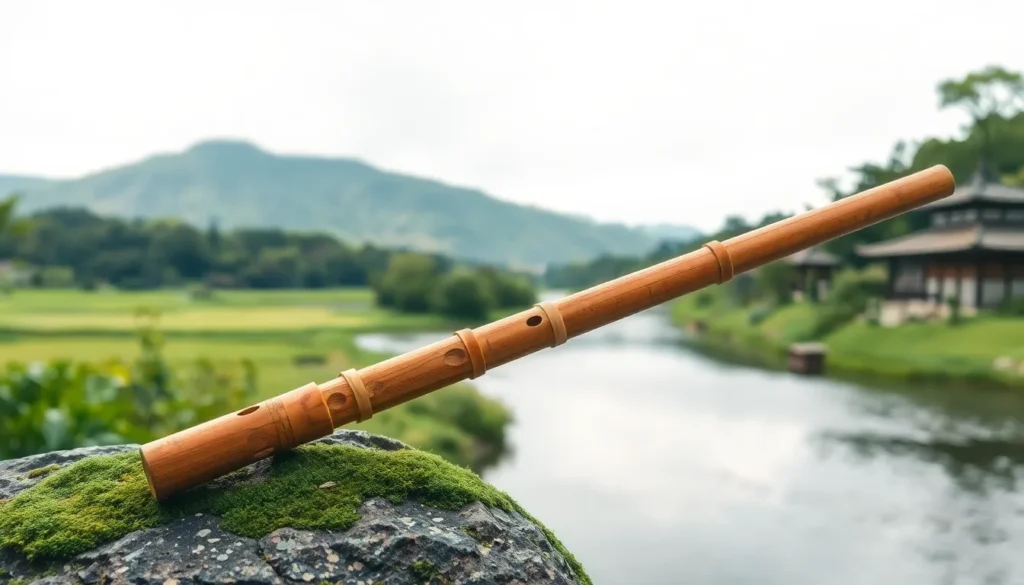In the vast, breathtaking world of Ghost of Tsushima, players find themselves not just wielding a katana but also serenading the winds with enchanting flute melodies. Who knew that fighting Mongols could come with a side of musical talent? These flutes aren’t just a pretty accessory; they’re gateways to the rich culture of feudal Japan, offering players a chance to immerse themselves in the game’s stunning landscapes while channeling their inner bard.
Table of Contents
ToggleOverview of Ghost of Tsushima Flutes
Ghost of Tsushima features flutes that enhance the gaming experience in unique ways. These instruments connect players to the game’s rich cultural heritage.
Importance in Gameplay
Flutes in Ghost of Tsushima provide players with a means to shape their environment. Playing melodies can alter weather conditions or prompt specific reactions from the world. These flutes act as tools for exploration and create moments for reflection. Engaging with the flute allows characters to express emotions, reinforcing narrative elements. Players often find melodies integral to navigating the lush landscapes. By interacting with the flutes, they deepen the immersion while uncovering secrets of Tsushima.
Historical Context
Flutes in the game represent a significant aspect of Japanese culture. Traditional flutes, like the shakuhachi, played vital roles in feudal Japan’s music scene. Historically, these instruments were linked to spiritual practices and meditation. Musicians often used them in formal ceremonies and festivals. Ghost of Tsushima incorporates these cultural elements, emphasizing authenticity. The game’s sound design showcases flute melodies that evoke the ambiance of historic Japan, enriching the player’s overall experience. Understanding this context enhances appreciation for the game’s artistry and storytelling.
Types of Flutes in the Game

In Ghost of Tsushima, flutes play a crucial role in enhancing gameplay and immersing players in the cultural landscape. Two notable types of flutes enrich the player’s experience as they journey through feudal Japan.
Jin Sakai’s Flute
Jin Sakai’s flute serves as the primary instrument throughout the game. This unique flute allows players to create specific melodies that influence the environment. These melodies can change weather conditions, summon animals, or create moments of reflection. Players use this flute to invoke feelings of nostalgia and connection to their surroundings. The emotional resonance of Jin’s flute deepens both character and narrative development, making it more than just a functional tool.
Other Flute Variants
Various other flute variants exist within the game to enhance play. Different melodies become available as players progress, each with distinct effects and cultural significance. Some variants might even serve particular purposes, such as altering time of day or affecting specific encounters within the world. Each additional flute showcases a different facet of Japanese musical tradition, contributing to the overall authenticity of the game’s soundscape. As players discover and use these flutes, they further enhance their journey through the beautifully crafted landscapes of Tsushima.
Musical Themes and Impact
Music plays a vital role in shaping the narrative of Ghost of Tsushima. The melodies resonate throughout the gameplay, enhancing storytelling and emotional engagement.
Role of Music in Storytelling
Music weaves through key moments, highlighting the struggles and triumphs of Jin Sakai. Each tune reflects his emotional state, connecting players to his journey. Crafted melodies often accompany pivotal scenes, evoking a powerful atmosphere. These soundscapes fill the world with authenticity, drawing players deeper into feudal Japan. By incorporating traditional instruments, the game enriches its narrative with cultural significance. Jin’s ability to influence the environment through music adds another layer to the story, making every note crucial in the quest against the Mongols.
Emotional Resonance of the Flute
The flute serves as an emotional anchor for Jin’s character. Each melody played evokes nostalgia, deepening the bond between Jin and the landscape. Sound design elevates gameplay experiences by integrating a range of emotions, from triumph to sorrow. Variants of Jin’s flute each carry unique meanings, enhancing moments of reflection and empowerment. Players often find themselves immersed in the tranquil beauty of Tsushima, as the haunting notes transport them to another time. Flute melodies symbolize resilience, reinforcing the character’s internal conflicts and growth. Each note connects players to the rich legacy of Japanese culture, creating a memorable auditory experience.
Gameplay Mechanics Involving Flutes
Flutes play a significant role in enhancing gameplay mechanics in Ghost of Tsushima. Players wield Jin’s flute to affect their surroundings and experience immersive storytelling through music.
Flute Mechanics and Features
Each flute in Ghost of Tsushima boasts unique mechanics and features. Jin’s flute serves as the primary instrument, allowing players to perform specific melodies that evoke changing weather patterns or trigger emotional responses from NPCs. Different melodies can summon rain for stealth or clear skies for combat. Additional flute variants provide distinct abilities, enriching gameplay by altering interactions with the environment. Each note carries cultural significance, deepening the connection players feel to feudal Japan and its traditions.
Flute as a Tool for Exploration
Exploration becomes immersive and dynamic when players utilize flutes during their journeys. Players find hidden areas and overcome obstacles by influencing environmental elements through music. The ability to change weather conditions encourages players to discover new paths or secrets. Reflective moments arise as players pause to enjoy breathtaking landscapes accompanied by soothing melodies. Utilizing flutes not only supports exploration but also enhances the emotional resonance of Jin’s story, creating a more profound connection to the game’s narrative and environment.
The flutes in Ghost of Tsushima offer players a unique blend of gameplay and emotional depth. They serve as powerful tools that influence the environment while enhancing the narrative experience. Each melody played resonates with Jin’s journey and connects players to the rich cultural backdrop of feudal Japan.
As players navigate the stunning landscapes of Tsushima, the haunting notes of the flute create moments of reflection and empowerment. This integration of music into gameplay not only elevates the overall experience but also reinforces the emotional stakes of Jin’s quest. The flutes truly embody the spirit of the game, making every note an essential part of the adventure.

